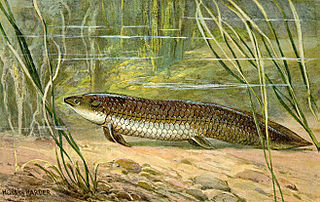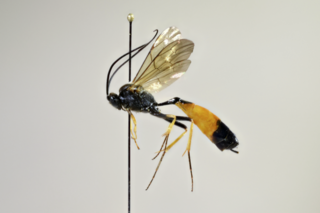
Caenorhabditis elegans is a free-living transparent nematode about 1 mm in length that lives in temperate soil environments. It is the type species of its genus. The name is a blend of the Greek caeno- (recent), rhabditis (rod-like) and Latin elegans (elegant). In 1900, Maupas initially named it Rhabditides elegans. Osche placed it in the subgenus Caenorhabditis in 1952, and in 1955, Dougherty raised Caenorhabditis to the status of genus.

Ctenochasma is a genus of Late Jurassic ctenochasmatid pterosaur belonging to the suborder Pterodactyloidea. Three species are currently recognized: C. roemeri, C. taqueti, and C. elegans. Their fossilized remains have been found in the Solnhofen Limestone of Bavaria, Germany, the "Purbeck Group" of northeastern Germany, and the Calcaires tâchetés of eastern France.

Ceratodus is an extinct genus of lungfish. It has been described as a "catch all", and a "form genus" used to refer to the remains of a variety of lungfish belonging to the extinct family Ceratodontidae. Fossil evidence dates back to the Early Triassic. A wide range of fossil species from different time periods have been found around the world in places such as the United States, Argentina, Greenland, England, Germany, Egypt, Madagascar, China, and Australia. Ceratodus is believed to have become extinct sometime around the beginning of the Eocene Epoch.

The elegant water shrew is a species of mammal in the subfamily Soricinae of the family Soricidae. It is the only species within the genus Nectogale. It lives in Sikkim and China.
In this checklist are presented all wasp species of family Ichneumonidae found within the UK.

Naso elegans, the elegant unicornfish, the blonde naso tang, Indian orange-spine unicorn, lipstick surgeonfish, lipstick tang, orangespine unicornfish or smoothheaded unicornfish, is a species of marine ray-finned fish belonging to the family Acanthuridae, the surgeonfishes, unicornfishes and tangs. This species is found in the Indian and western Pacific Oceans.

Corixa is a genus of aquatic bugs in the family Corixidae. The fossil species C. elegans is from the Rott Formation in Nordrhein-Westfalen.
Chitaura elegans is a species of grasshopper found in Indo-Malaysia.
Chromulina elegans is a species of golden algae in the family Chromulinaceae. It is found in freshwater, in Europe, South America and Asia.
Coscinopleura is an extinct genus of prehistoric bryozoans in the family Coscinopleuridae. Species are from the Paleocene of Sweden and New Jersey, United States. C. elegans and C. angusta are from the Senonian and Danian of Denmark.
Drosophila elegans is a flower-feeding species of fruit flies, belonging to the family Drosophilidae. It is found in Taiwan and the Philippines in Asia.
Drosophila statzi is an extinct species of flies, belonging to the family Drosophilidae. It is from the Upper Oligocene of the Rott Formation in Germany.

Bauruemys is an extinct genus of turtles in the family Podocnemididae.

Dusona is a genus of parasitoid wasps belonging to the family Ichneumonidae. It is the most species rich genus of the subfamily Campopleginae with 442 known species.

Dusona falcator is a large species of parasitic wasp belonging to the family Ichneumonidae, subfamily Campopleginae. It is a parasitoid of the buff-tip moth. It is one of the largest known species of Camopleginae, able to reach sizes over 20mm. The species can be found throughout the Palearctic realm.
Dusona abdominator is a species of parasitic wasp belonging to the family Ichneumonidae, subfamily Campopleginae.
Dusona juvenilis is a species of parasitic wasp belonging to the family Ichneumonidae, subfamily Campopleginae. It is a parasitoid of Eupithecia haworthiata larvae.

Dusona leptogaster is a species of parasitic wasp belonging to the family Ichneumonidae, subfamily Campopleginae. It is a parasitoid of Geometrid moth larvae, the two known hosts being Alsophila aescularia and Lomaspilis marginata.
Dusona nidulator is a species of parasitic wasp belonging to the family Ichneumonidae, subfamily Campopleginae. It is a parasitoid, but the host is unknown.
Dusona terebrator is a species of parasitic wasp belonging to the family Ichneumonidae, subfamily Campopleginae. It is a parasitoid of Noctuid moth larvae.








